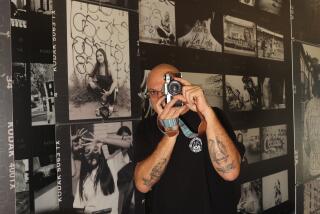Morris Engel, 86; Indie Film Pioneer Made ‘Little Fugitive’
- Share via
Morris Engel, a still photographer whose landmark 1953 film “Little Fugitive” inspired an era of independent filmmaking by better-known mavericks such as John Cassavetes, Francois Truffaut and Quentin Tarantino, has died. He was 86.
Engel died of cancer March 5 at his home overlooking New York’s Central Park.
The innovation and daring of Engel and his late wife, photographer Ruth Orkin, set the scene for the independent movement that has been reshaping Hollywood for half a century.
“Our [French] New Wave would never have come into being,” Truffaut once told the New Yorker, “if it hadn’t been for the young American Morris Engel, who showed us the way to independent production with his fine movie ‘Little Fugitive.’ ”
The modest black-and-white film, which Engel and Orkin co-created along with Ray Ashley for $30,000, won the Venice Film Festival Silver Lion Award, was nominated for an Academy Award for best screenplay and in 1997 was included by the Library of Congress in the National Film Registry. Leonard Maltin, in his annual Movie & Video Guide, rates the film “a minor classic.”
The simple story focuses on Joey, played by Richie Andrusco, a 7-year-old Brooklyn street kid who is tricked into thinking he has fatally shot his 11-year-old brother, who is eager to escape minding him while their widowed mother works. Urged by the brother’s friends to go on the lam, Joey takes the family grocery money and lights out for Coney Island.
Engel, using a hand-held camera he developed, depicts the fabled amusement park in its heyday at the little boy’s eye level, enabling viewers to share the child’s fear and fascination with hucksters, cotton candy and pony rides before his family finally comes to find him.
To create the film, Engel ignored standard concepts of moviemaking -- cameras on tripods, color, careful scripting, casts of hundreds and big budgets -- to shoot real life in real settings, using actual New Yorkers as extras.
“Whether so modest a film gets the wide distribution it deserves,” Times movie editor Louis Berg wrote in 1953, “depends on whether the big shots in the movie industry can be persuaded to turn their eyes away from their mammoth 3-D screens.... You will undoubtedly be able to see it at the ‘art’ houses.”
When Engel and his wife created “Lovers and Lollipops” a few years later, Berg wrote for The Times, “The Babes in the Woods have done it again.... And again they are likely to show up Hollywood.”
Cassavetes followed Engel’s bold example in 1959 with his $40,000 “Shadows,” and Truffaut produced his “The 400 Blows,” ushering in the French New Wave.
In 1998, Kino released a video titled “The Films of Morris Engel with Ruth Orkin,” with all three films made by the couple: “Little Fugitive” (1953), “Lovers and Lollipops” (1956) and “Weddings and Babies” (1958).
Engel subsequently created only one more feature film, “I Need a Ride to California,” which was never released. After his wife’s death from cancer in 1985, he made two video documentaries, “A Little Bit Pregnant” in 1993 and “Camellia” in 1998.
Born in the Williamsburg section of Brooklyn, and growing up a self-described “street kid” much like Joey, Engel became fascinated with photography at the age of 9, devouring travel pictures in brochures he cadged from steamship lines.
Engel went to work in his teens as a bank clerk but signed up for a $6 course at the Photo League and began roaming the streets of New York with his camera.
He soon turned his random photos of children at play and little old ladies sitting on stoops into a seven-page spread in the new newspaper PM. The paper liked his work so much that it hired him.
Engel enlisted in the Navy during World War II and was assigned to Combat Photo Unit No. 8, photographing the D-day landing at Normandy, France.
After the war and the demise of his employer PM, he photographed for magazines such as Collier’s and McCall’s.
Although his luminous film achievements overshadowed his still photography, Engel was respected for his decades of photojournalism. His photographs from 1935 to 1951, along with many by his late wife, were exhibited in 1999 by New York’s Howard Greenberg Gallery.
Engel is survived by a son, Andy; a daughter, Mary; two sisters, Pearl Russell and Helen Siemianowski; and a grandson.
More to Read
Only good movies
Get the Indie Focus newsletter, Mark Olsen's weekly guide to the world of cinema.
You may occasionally receive promotional content from the Los Angeles Times.










